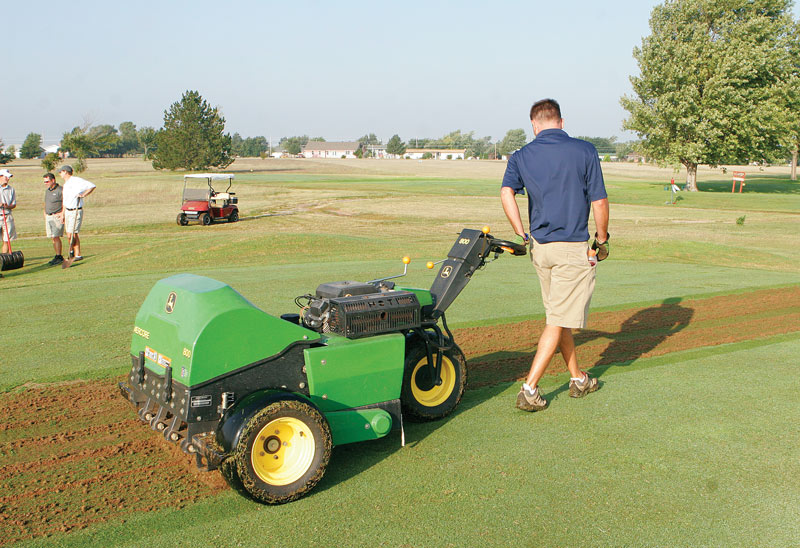
A volunteer aerates the grounds at Cannonball Golf Course in Greensburg, Kan. Photo by Scott Hollister
If you’ve ever attended your favorite high school’s Friday night football game and looked at the center section of the field, you’ve probably seen some sparse turf. Whether on golf courses, sports fields or playgrounds, no turf area is immune to the devastating effects of compaction.
You’ll also find compaction around the goal on a soccer field, the path that always appears between the same two bunkers where people walk from their golf cart to the green, or just where people take that proverbial shortcut through the grass to the sidewalk. These are only the visible signs — the “tip of the iceberg” — of the compaction problems that are really present in your soil.
Once you know it’s there, you know it must be remedied. Superintendents relieve compaction primarily through mechanical cultivation, namely aeration. You can choose many methods of aerifying for the differing conditions and situations in a given area, and each will yield a different result. Which method is best: deep or shallow tines, coring or solid tines, slicing blades or vertical linear aeration (deep power slicing)?
After more than 20 years in the aeration business and visits to thousands of golf courses, athletic complexes and sports fields in the U.S., Canada and Mexico, I’ve found that while the problems are all the same, the options for solving them have clear advantages and disadvantages.
Deep tines vs. shallow tines
For turf managers, the age-old question is, “Should I deep-tine or shallow-tine?”
Several years ago, the late Houston Couch, Ph.D., spoke on the subject of deep-tine aeration, and I heard a superintendent ask, “My old aerifier went 3 inches deep and the root system stopped there. My next aerifier went 4 inches deep and the roots stopped there. Now I started deep-tine aerifying, and my roots seem to be stopping there. What can I do now?” Couch looked perplexed and responded, “And what’s the problem with 10-inch roots?”
Couch’s remark encompasses my view in a nutshell. Given the choice, go deep. It’s true that the root system usually stops where aeration tines stop. But at 10 inches deep, the root system will support a healthy stand of turf. I’ve even seen 10-inch Poa annua roots in golf greens.
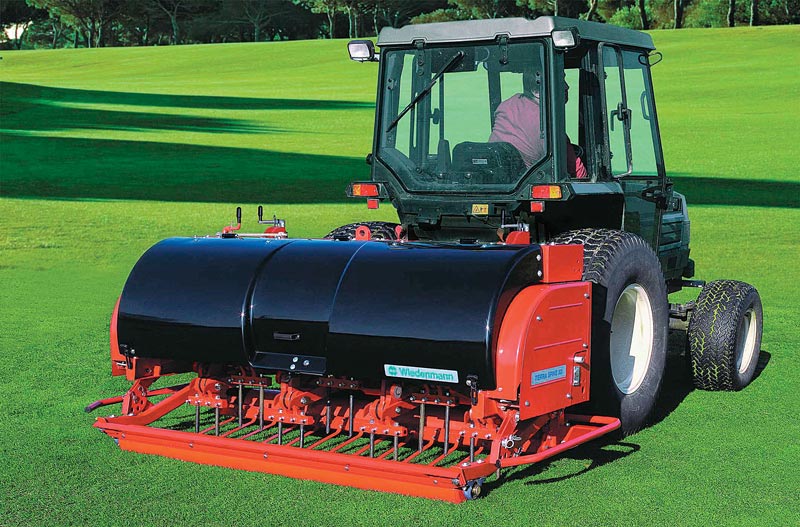
Deep-tine aerification promotes a deeper root system and allows superintendents to lengthen irrigation intervals. Photo courtesy of Wiedenmann Ltd.
With a deeper root system from deep-tine aerification, you lengthen irrigation intervals, fertilizer applications last longer, and you introduce more oxygen into the soil. Some golf courses have completely amended the top 12 inches of their greens’ soil profile through the creation of deep sand tunnels from topdressing after using large tines and up to 1.5 tons of sand per 1,000 square feet. This amounts to virtually rebuilding the green from the inside out without taking it out of play, and it saves thousands of dollars.
The old rolling-type shallow aerifier is still cheap and fast, but it offers minimal compaction relief and generally produces tufting around the holes. The newer deep-tine heaving machines are faster (more than 2 acres/hour), so deep-tine aeration is now more economically feasible for multiple athletic complexes and golf course fairways.
Before you start a deep-tine program, make sure irrigation lines and wires are deeper than the aerifying depth. I’ve seen lots of “scenic fountains” pop up unexpectedly during deep aerification.
Straight-up-and-down vs. heaving
Another question is whether to choose a machine with “straight-up-and-down” (SUD) tine action or heaving action. I recommend a heaving-action aerifier for most applications. With the SUD action of conventional aerifiers, compaction relief between the holes is minimal at best. SUD aerifiers, although still manufactured, are a bit out of date given the newer aerification technologies. Even the vertical drilling machines produce little to no compaction relief between the holes.
I recommend choosing an aerifier with a positive heaving action that breaks up the compacted soil between the holes. This introduces needed oxygen, will increase the total cation exchange capacity, and can improve drainage both horizontally and vertically throughout the soil profile. Plus, at the bottom of each stroke, the heaving tine is moving horizontally as it is moving vertically, adding a slicing action to the lifting action in the turf.
This motion minimizes the creation of a hardpan layer caused by the traditional pounding action of the old SUD aerifiers. Rather than compressing the soil and actually adding to the compaction problem, the process of heaving displaces the soil upward, raising the playing surface from “not noticeable at all” to 1/2 to 3/4 of an inch, depending on how the machine is adjusted. Matching the extent of the heave for the given soil conditions can be critical in producing good results. For example, after using needle tines, the putting surface should be smooth without using any topdressing, and it should putt smoothly even after using larger tines and a light topdressing.
Solid tines vs. coring tines
Here is another brainteaser: Should you use solid or coring tines? The answer depends on what you’re trying to accomplish. Although solid tines are available in either SUD or heave-action aerifiers, I recommend using a heaving machine when choosing solid tines, because an SUD aerifier with solid tines can do more damage than good.
SUD aerifiers with solid “shatter tines” will break up the soil, but only if the conditions are desert-like — rock hard or bone dry. Consequently, the aerifier has a hard time driving the tines into the ground to any considerable depth without causing undue damage to the turf and the machinery. You can use SUD aerifiers with solid tines as shallow pin spikers (possibly on hydrophobic greens or “in season” athletic fields), but they’re really only good for opening the thatch surface during high-stress times, allowing for quick water and air penetration with minimal disturbance to the surface or subsurface. Again, this is only opening the surface, not relieving compaction.
Using this method too much causes an even more serious problem. The SUD aerifier will create a “sheep’s-foot roller” effect and a really bad hardpan layer in the soil profile. I’ve seen hardpan layers so severe that not only was there a toxic gas buildup underneath, but the soil also had a toxic chemical layer.
Editor’s note: Get help identifying your soil’s problems, determining best remedies and more in our guide to fine-tuning turfgrass cultivation.
So, when using SUD aerifiers, whether going deep or shallow, avoid using solid tines and stick to coring tines for compaction relief. You can use solid tines effectively with deep-tine heaving-type aerifiers with little or no damage to the turf. They will relieve the shallow hardpan and toxic layer created by the SUD machines. With solid tines ranging from 3/16 inch to 1 inch in diameter and 6 to 16 inches in length, the ground doesn’t need to be bone dry, but only needs sufficient moisture for optimal penetration and compaction relief. Don’t choose an aerifier that merely pokes a hole (deep or shallow) with no heaving action, as those are just “shatter tining” and can contribute to compaction.
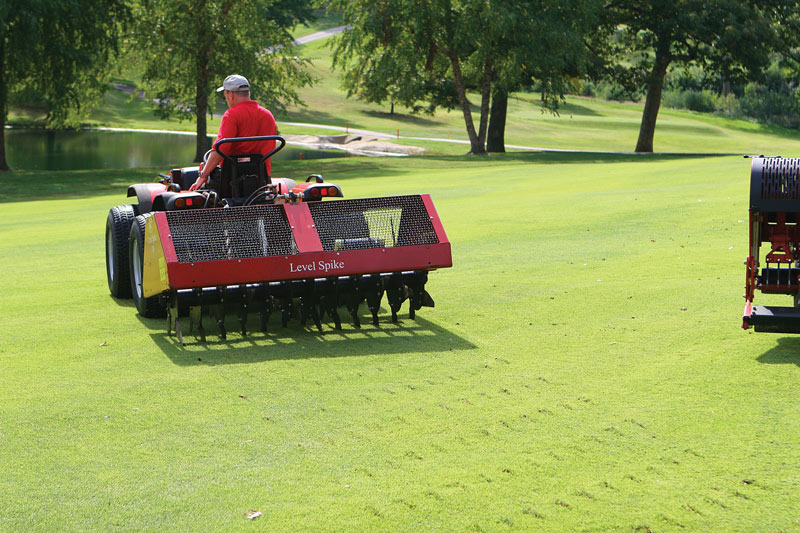
Use a combination of knives and spoon tines to aerate and improve drainage. Photo by Seth Jones
Almost all aerifiers offer some type of coring tine. Most people think you have to pull a core for thatch removal, but that process only provides 5% of the total thatch removal necessary. On a green, about 95% of thatch control comes from verticutting and topdressing. The 5% of thatch that isn’t removed with solid tines instead of coring tines can cause trouble during hot, high-stress times when the green surface can become hydrophobic and repel irrigation water. Ironically, most athletic field managers would love to have some thatch in the middle of a football field to protect the crowns of the plants and keep the players from making a muddy “pigpen” of the field during wet conditions.
Turf managers who opt to use no-mess solid tines on a golf course should add an extra verticutting and topdressing. Your turf will love you for it, and the channels you create with the deep tine will make a permanent chimney of sand, allowing water and roots to penetrate with ease.
Vertical linear aeration vs. reciprocating
Another choice for compaction relief is the relatively new method of deep power slicing, called vertical linear aeration (VLA). The soil-loosening capability of this machine is similar to that of the deep-tine heaving machines. The difference is in the consequences of VLA’s use of blades rather than tines.
VLA machines aerate by driving 10- to 16-inch blades through the soil. They are mounted on a rotating shaft and powered by a chain drive from the PTO-driven gearbox. These blades are offset in their mounting to penetrate the ground in alternating fashion and create a side-to-side “wave” action to loosen the turf. They do not bring any soil to the surface, but do provide a considerable degree of compaction relief.
VLA machines produce a continuous slit in the ground, which exposes the turf to drying or desiccation along the edges of the slice and requires increased irrigation during the healing time. Given the same soil conditions, VLA machines can usually penetrate deeper than a reciprocating deep aerator. VLA machines use far fewer moving parts and are easy and less expensive to maintain.
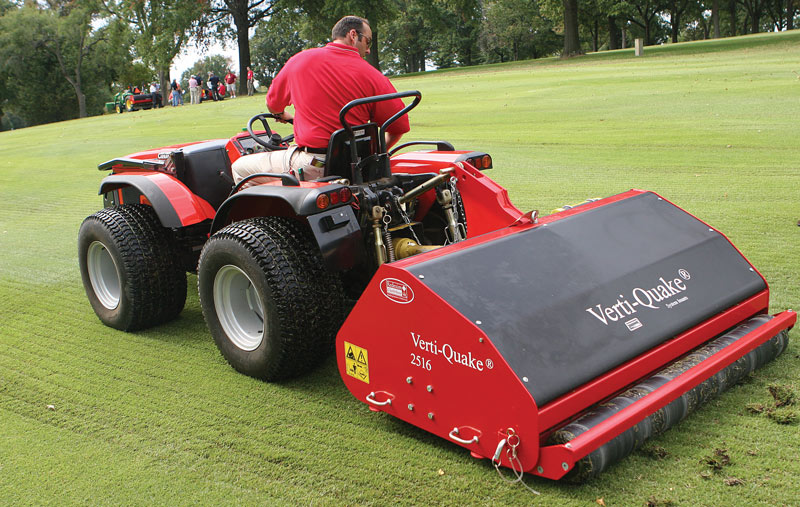
Vertical linear aeration does not bring soil to the surface but provides compaction relief by loosening the turf. Photo by Seth Jones
I recommend this method for heavily compacted soils that may be extra hard or rocky and more difficult for a deep-tine aerator to penetrate. These machines can also be equipped with sand hoppers that will gravity-feed sand into the slits for improved drainage.
Slicing rollers
The slicing roller, yet another aeration choice, sounds simple because it is. Slicing, although not really intended for compaction relief, can be beneficial to turfgrasses that produce stolons and/or rhizomes, such as bluegrass, zoysiagrass and bermudagrass. Slicing the stolons and rhizomes creates new mother plants that send out new rhizomes and stolons with a vertical growth pattern. A VLA machine also accomplishes this, as will — to a lesser degree — any of the aforementioned techniques. The soil-loosening effects are generally minimal. In fact, with extended use, you may increase compaction through the “sheep’s-foot roller” effect, so some kind of compaction relief program will be necessary.
Some slicing models are designed with twisted or angled heaving knives to provide some compaction relief. These have some loosening capabilities but may cause damage to the turf. It’s a cheap way to aerify if you can afford the healing time.
Oscillating solid tines
While a little too aggressive for fine turf areas such as golf course greens, these machines are a good choice for fairway, rough and athletic field applications. They do an excellent job of loosening the top 4 to 6 inches of the soil profile. They use only solid tines and don’t pull out or destroy any of the existing turf. This type of aerifier ranked among the best tested for compaction relief in the soil’s top 5 inches in a University of Georgia study. These machines can also be fitted with a seed box for seeding while aerifying.
Water injection
Water injection can be a useful mode of aerifying in certain situations. This type of aerifier works by injecting water under high pressure into the soil. This can be especially helpful when the turf becomes hydrophobic during summer stress. You must have access to a water source through a quick coupler.
These injection machines create almost no surface disturbance, and the grounds can be returned to playing status immediately after treatment.
Dry material injection
The dry material injection machines work on the same theory as water injection. They inject water, but dry material is also pulled by siphon effect from a hopper mounted above the injectors. Various soil amendments can be added in this manner for a variety of plant needs.
Drill and fill
The “drill and fill” machines have been on the market since the mid-1980s and have been useful in many cases for amending turf areas with poor soil. These machines can go as deep as some of the deep-tine machines on the market, and in some situations can be used with less surface disturbance. This type of aerifier has a few drawbacks:
- They are slow compared with reciprocating deep-tine machines (about a fourth of the speed, depending on soil type and depth).
- Keeping the material hoppers filled can be labor-intensive.
- The drill makes a hole, but does minimal — if any — loosening between the holes.
These machines create minimal disturbance to the surface of the turf, and playability afterward is very good.
Micro tining
Micro tining is performed primarily on golf course putting greens. Very small solid or coring tines, 1/4 inch in diameter or smaller, can be used to effectively dethatch and/or ventilate a putting green surface. Micro tining does not decompact the soil given that these tines only penetrate the thatch surface and shouldn’t get into the soil.
Maximum micro-tining depth is generally 1.5 inches. With the small tine diameter and shallow depth, the green is under very little stress as the oxygen and gas exchange takes place (thus the term “ventilating”). The spacing of these holes should be no farther apart than 3 inches by 3 inches.
During the growing season, I’ve seen these holes heal over by the next day. The “micro cores” can be blown off by a leaf blower or mowed up with a greens mower. Because they are not getting into the soil, this generally doesn’t impose a bedknife wear issue.
Preventive vs. curative
Superintendents frequently ask how often they should deep-aerify. My answer is that turf managers must first understand deep aeration as a means of preventing compaction rather than relieving it.
As a superintendent, I deep-aerified greens every spring and fall, and I needle-tined greens during summer. I also deep-aerified my bermudagrass fairways during summer, all with a deep-heaving machine. In this way, the problems associated with compaction were greatly reduced and my turf generally flourished, even in hot weather.
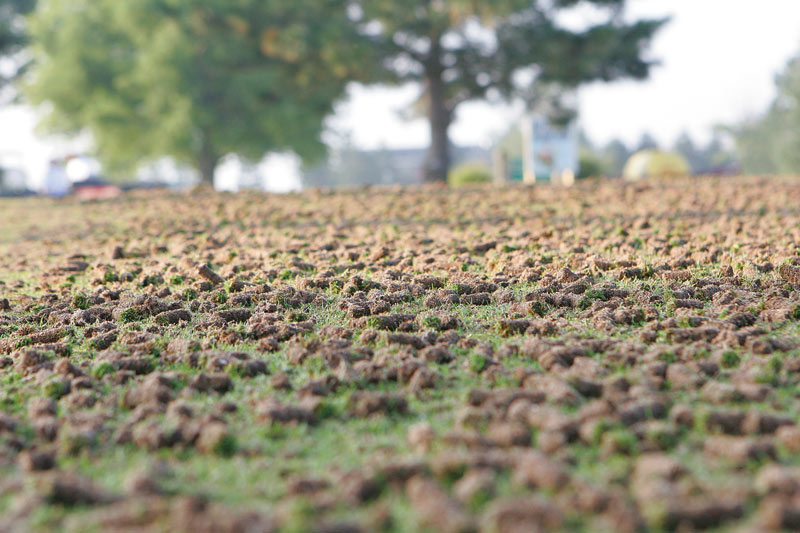
If you are responsible for maintaining sports fields, you could adopt a program of deep aerating as often as desired, but a tight budget may determine the frequency of your aerification program. For example, if you own a machine, a program of ongoing use doesn’t cost much more than the occasional use, except for additional topdressing, tines and labor. If you choose the ongoing program, you’ll find that the tremendous savings in applied chemicals, irrigation water and greens rebuilding will more than offset the purchase price of a deep aerator.
For those with limited budgets, financing a machine is a way to expand your aerification program and receive the accompanying savings. Many customers hire a contractor to get the job done. They have a couple of reasons for contracting the job out: They are relying on the experience of the personnel and want to see results before they make their purchase, and just a spring and/or a fall deep-tine aerification program yields unparalleled results compared with conventional aerifying and is reasonably priced by many contractors.
Choose a company that uses the best aeration equipment and employs experienced operators who will make correct decisions for your turf conditions. Knowing the proper machine adjustments, hole spacing, tine choice, soil/turf tolerance and weather conditions will greatly affect customer satisfaction in terms of healing time and playability.
It’s impossible to discuss every brand and type of aerifier on the market, but I hope this overview helps when making aerification decisions. Whether you’re purchasing an aerifier or hiring a contractor, choosing the proper machine and operator, combined with the proper tines or blades for the desired application, can make the difference between satisfaction and disappointment.
Remember: Don’t be too radical at any one time. The main things to keep in mind for a successful aerifying job are not to force the machine beyond its capabilities and not to use too large of a tine or a spacing that’s too close for the conditions. The soil didn’t get compacted overnight, and rarely can compaction be completely alleviated in one treatment. The best route to optimal improvement is making all the right choices, and now, hopefully that’s easier done than said.
Bryan Wood is a former golf course superintendent and the owner of Commercial Turf and Tractor, an equipment and contract service provider for the golf course and sports turf industries, in Chillicothe, Mo.